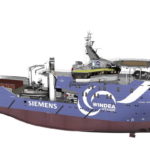Specialty shipbuilding faces new challenges every day. Offshore supply vessels operating in harsh weather and rough seas need special technologies. Thus Norwegian shipbuilder Ulstein keeps developing new designs for the demanding segment
With introducing the unusual X-Bow design ten years ago, Ulstein raised eyebrows. The bow demonstrated it could reduce the[ds_preview] effects of rough seas compared to ship with bulbous bows. While increasing crew comfort it also gives the opportunity to keep up speed in foul weather or the option of reduced fuel consumption. Close to 100 vessels are being constructed or have since been delivered worldwide with the new bow, Ulstein says.
While in shipbuilding the focus mainly seems to lie on bow forms in order to optimize ship efficiency, Ulstein is taking a closer look at the stern. Recently the company has launched its X-Stern concept. It has been nominated as one of the top four candidates for the Next Generation Ship Award that recognizes achievements in innovative ship designs. The winner will be announced at the Nor-Shipping Opening Conference.
The sloping and higher stern allows a sharp stern shape in which the transom plate is replaced by a pointed aft. The X-Stern leads to reduced pitch and wave drift forces as well as eliminating slamming, the shipbuilders say. This results in a reduced power and fuel consumption while on DP, or the possibility of operating in a wider sector with the same power consumption. As Ulstein explains, an X-Stern vessel can stay on position in harsh weather with the stern towards waves, wind and current. The stern design is similar in its characteristics to the X-Bow and has ice operation capabilities. Due to the stern shape and the enclosed aft deck, the sea is kept off the deck, preventing or reducing ice build-up in arctic areas.
An offshore wind service vessel’s most important task is to stay positioned on DP close to the turbines, with as little movements as possible, in order to provide a safe transfer for the technicians from the vessel through a heave compensating gangway to the turbines. The vessel can operate with stern (X-STERN) or front (X-BOW) towards wind, waves and current, increasing the operational window.
After introduction in Q3 2014, the first two design and shipbuilding contracts for X-Stern vessels were signed for the sustainable wind energy market, for delivery to Bernhard Schulte. In January Siemens announced the signing of a chartering agreement with Bernhard Schulte for theses two service operations vessels (SOV) for the long-term service and maintenance operations of the Gemini and Sandbank/Dan Tysk offshore wind power plants in the North Sea. The vessels will become operational in 2016 and 2017 when both the Gemini and Sandbank offshore wind projects are scheduled to start operations.
The efforts of the Norwegian company to ever improve its designs are necessary to survive in the market. »Many new actors are entering the offshore scene«, Deputy Managing Director Per Olaf Brett says. Ulstein’s answer to this is reducing the costs of newbuildings while at the same time improving the efficiency and efficacy of OSVs.
Challenges and chances
Besides competition from Asia, the future also bears chances for the long-standing company. »Over the next three to five years, the oil price will gradually increase due to higher consumption and controlled production and again encourage and stimulate increased investments in E&P«, says Brett. Thus, the offshore oil and gas activity would pick up growthwise and improve the supply and demand balance, which at the moment, he says, is very much in imbalance. »Supply is superseding demand with the consequences of low activity, low rates, and distressed operations.«
To stay competitive under these circumstances and to meet the customers demand for more efficient vessels, Ulstein ist constantly working on new designs, state-of-the-art hull platforms and topside solutions, Brett explains. Recently Ulstein announced the beginning of steel cutting for their first ingerated vessel design for Van Oord, where Ulstein is responsible for the vessel design as well as for the mission equipment.
»First and foremost we are developing a completely new concept for measuring, benchmarking and rating vessel designs for their performance yield to determine what is a better ship. Ulstein is also working on new approaches to greener, safer and smarter vessels«, Brett points out more areas of development. Also LNG-fuelled vessels could be delivered but so far there seems to be no demand for this technology in the industry.
Felix Selzer


















